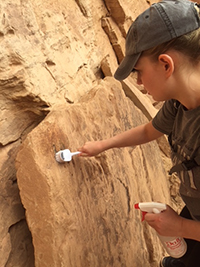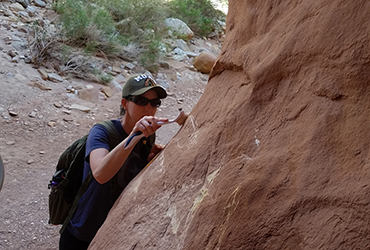As visitors explore the park, conduct field work, or collect data for research, we ask that they adhere to The Leave No Trace Center for Outdoor Ethic's Seven Principles. These guidelines were created to preserve pristine places and to help minimize user impacts. Although they are not official park rules, the Seven Principles are a great way to preserve protected lands like Capitol Reef National Park.
When traveling in the park, be sure to know where you are going and what provisions you need to bring. Be aware of current weather, road, and trail conditions. If you are camping in the backcountry, make sure you obtain a permit from the Visitor Center. Be sure to carry enough water, food, clothing, and maps for everyone in your group. Keep group sizes as small as possible, but try to take at least one other person with you. Plan your route and consider paths that help prevent damaging any part of the ecosystem. For example, avoid trampling plants or biological soil crusts. Most importantly, before you head out, make sure that someone knows your travel plans.
Don't bust the crust! Biological soil crusts are actually alive and often overlooked, yet they are a key part of desert ecosystems. These crusts are important for providing soil nutrients, aiding moisture retention and for preventing erosion. The soil is recognizable by its black, crusty surface. Cryptobiotic soil, as it is also known, takes many years to redevelop from the damage of a single footprint. Please remain on trails and follow routes that do not cross through areas of biological soil crusts.

Stay on terrain that will not be damaged by traveling across it; trails, washes, loose sand, gravel, and exposed rock are preferred surfaces in the desert. Hike on existing trails and camp in previously impacted areas to limit further damage. Hiking in a single-file line to prevent trail widening is particularly important in the desert.
Pack it in, pack it out! Litter is unsightly, harmful to wildlife, and takes many years to decompose in the dry, desert environment. Please do your part by looking for and carrying out all litter and food scraps - yours or not.
At CRFS, we try to minimize water usage, however, it is better to use our facilities than to "do your business" out in nature. If you must "go," dig a 6-8 inch deep cat hole 150 steps away from all trails, campsites, water sources, or archaeological sites. Bury your human waste, but pack out the used toilet paper.
Take only pictures, leave only footprints! With every damaged or stolen artifact, we lose the ability to understand and learn from other cultures that called this area home. Many heritage sites are also considered sacred by modern tribes, so please be respectful and help protect and preserve their history.
Once of the best ways to protect cultural sites is to keep them a secret, always leave what you find, and be discrete. Artifacts, to the untrained eye, often go unnoticed and may become damaged by foot traffic. Please try to observe from afar and do not disturb anything. Oils from your skin or chemicals from bug repellant or sunscreen may be especially damaging to petroglyphs and historic inscriptions. Vandalizing archaeological sites carries a fine up to $20,000 and up to one year in prison.
Petroglyphs and historic inscriptions are found throughout the park, so do not add your own. Graffiti and rock cairns built by visitors are problematic and often start bad trends that others follow. These activities degrade the resource, are unsightly, and can be costly and time consuming to remove. Never leave anything that takes away from other visitors' experiences.
In Capitol Reef National Park campfires are only allowed in fire rings at three established campgrounds: Fruita, Cedar Mesa, and Cathedral Valley. Outside these designated areas use camp stoves for cooking and battery-powered lights or lanterns for visibility. Consider using lights on the lowest possible setting or a red light, when available, to minimize light pollution. CRFS considers the dark night sky a valuable resource.

A fed animal is a dead animal.all plants and animals in the park are protected. Remember, we are visitors in their home, so please be respectful. Keep enough distance from wildlife as to not interfere or alter their behavior. Keep all food, trash, and cooking equipment in a location that animals cannot easily access. Animals that eat our food lose their ability to survive on their own and can get sick. Animals can also become aggressive towards humans if they become accustomed to our food.
When viewing wildlife, use the "rule of thumb" to determine a safe viewing distance. With your thumb outstretched, if you can completely cover the animal in your field of view, you are at a safe distance. If you can still see part of the animal, move away to a safer distance.
While at CRFS or exploring the park, be courteous and mindful of other visitors. When in large groups this is extra important. Keep noise to a minimum. If you are at an overlook or point of interest, don't hog the view! Be aware of others taking pictures and let everyone have a turn.
When hiking, yield to others going uphill by stepping to one side of the trail. Allow smaller or faster groups to pass you. Be polite and respectful. Be good representatives of UVU and CRFS.